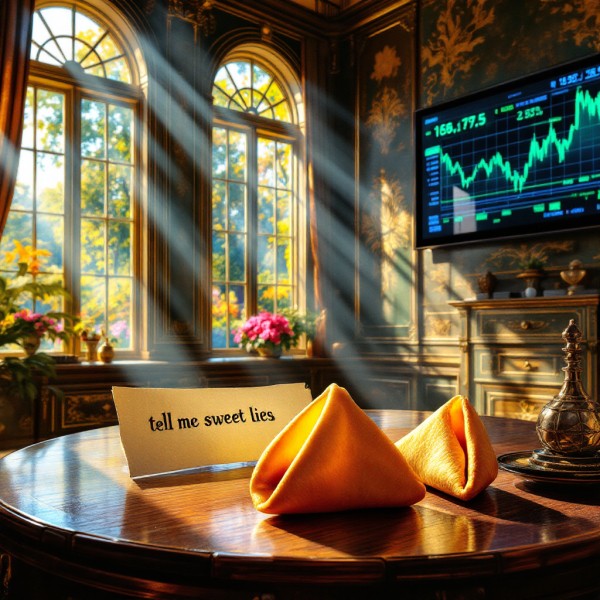6-Month Stock Market Forecast? Flip a Coin or Read the Crowd
April 16, 2025
Let’s be blunt: obsessing over the next six months in the stock market is a polished form of financial masturbation. Sounds harsh? Good. Because if you’re watching CNBC with a notepad and hoping for clarity, you’re not investing—you’re gambling. You’re not allocating capital. You’re chasing smoke in a mirror maze. And the deeper irony? Most who focus on short-term forecasts are the first to get wrecked when the tide shifts. They buy at tops, sell at bottoms, and call it “caution.” It’s not caution. It’s cowardice wrapped in dopamine.
The Tactical Investor’s Burro Theory: A Quick Reality Check
Let’s bring in something painfully accurate: the burro theory.
The Tactical Investor laid it out clearly. The market is like a donkey in a field. You yell “bear market,” and it stands there. You shout, “Crash incoming!” It yawns. But if you poke it enough—bad news, interest rate chatter, China sneezing—it bolts in the wrong direction. Most traders chase it. They try to ride it mid-stampede. That’s when they get thrown off, stomped on, and trampled by the same donkey they were trying to predict.
That’s the market in the short term—unruly, noisy, random. You don’t tame a burro with forecasts. You move around it with awareness, patience, and strategy. And you certainly don’t try to mount it every six months because Goldman Sachs updated its “macro outlook.”
Speculation Is Not Strategy
What most people call “investing” is really a game of dressed-up speculation. They slap technical terms on it—momentum indicators, trend reversals, Fibonacci extensions—but the core remains the same: short-term bias, emotional fuel, and an insatiable need to do something. As if action equals control.
But investing isn’t about activity. It’s about positioning. Not predicting. You don’t predict hurricanes; you build a house that can take the wind.
Short-term market forecasts? That’s the fast food of financial thinking. It feels good going in. Leaves you bloated, broke, and blaming the Fed on the way out.
Mass Psychology: Why the Herd Always Screws Itself
You know the pattern. Market tanks. Panic everywhere. Everyone suddenly turns into a macroeconomic expert overnight.
“This is it.”
“It’s different this time.”
“I’m going to cash out until things stabilise.”
Stabilize? Do you hear yourself?
By the time things “stabilise,” the market’s already up 30%, and you’re sitting in cash wondering how you missed it—again. The same people selling at the bottom in 2020 were the ones screaming FOMO by September.
That’s how herd behavior works. When the market crashes, they sell because it’s crashing. When it rallies, they buy because it’s rallying. And every damn cycle, they forget that they’ve done this before.
Behavioural finance has a term for this: recency bias. What just happened must be what will happen. And so they ride the rollercoaster, blindfolded, vomiting over the side and asking for another ticket.
Technical Analysis: A Tool, Not a Tarot Deck
Now, don’t get it twisted. Technical analysis has its place. It’s a powerful lens for understanding crowd behaviour, charting sentiment, and spotting psychological inflexion points. But using TA to forecast the next six months? That’s like trying to time earthquakes with seismographs. You’ll spot tremors, sure—but you’ll never predict the epicentre.
TA is best used to frame probabilities, not certainties. You use it to stack the odds, not dictate the script. When do people use RSI and MACD to call precise market tops and bottoms? That’s not analysis. That’s superstition.
Vector-based thinking—nonlinear, pattern-aware, macro-psycho synthesis—is the real game. You align technical signals with crowd emotion, liquidity cycles, and structural macro shifts. Not one tool. A multi-sensory grid. That’s how you move ahead of the stampede—not behind it.
The Death Spiral of Forecast Addiction
Let’s call it what it is: forecast addiction. The need for monthly guidance. Weekly predictions. Daily sentiment updates. It’s the illusion of control.
But here’s the irony: the more you need to know what’s coming next, the less you can handle it when it does. You’ve outsourced your intuition to analysts. You’ve replaced conviction with consensus. And now you’re paralysed every time the S&P drops 1.2% on a Wednesday.
You’re not managing money. You’re working your anxiety through charts and headlines.
And that’s why the market punishes short-term thinkers. It preys on the emotionally fragile and intellectually lazy. It rewards those who can zoom out, hold fast, and act when the crowd freezes.
Who Really Wins? Those Who Stop Watching
Let’s look at history.
- The ones who bought during the March 2020 crash and stopped watching made millions.
- The ones who dollar-cost averaged during the 2008 meltdown? They’re still compounding.
- The ones who listened to “Michael Burry predicts crash incoming” every year since 2011? They’re still waiting for vindication, broke and bitter.
Short-term forecasts are the biggest time sink and wealth killer in modern investing. They seduce you with false precision and drain you with real uncertainty.
The market doesn’t care what your chart says. It’s going to do what it does. Your job isn’t to know the next move. Your job is to be ready for any move—and exploit it when others freeze.
Investing Is a Game of Time, Not Timing
Warren Buffett doesn’t forecast the next six months. He buys businesses that make sense over decades. Peter Lynch said more money is lost preparing for corrections than in the corrections themselves. But sure, keep chasing six-month predictions from influencers who launched a trading newsletter last week.
The market is a puzzle with missing pieces. You won’t solve it by staring harder. You solve it by understanding how the pieces move and being ready when they snap into place.
The Real Forecast? Pain for the Unprepared. Profit for the Patient.
Here’s your forecast:
- Volatility will spike.
- Sentiment will shift violently.
- A new “crisis” will dominate the headlines.
- The crowd will panic, again.
- Institutions will scoop up discounts, again.
- And the smart money will exit while the retail herd finally jumps in.
That’s the cycle. That’s always been the cycle. Forget the dates. Watch the behaviors. That’s where the real edge lives.
Conclusion: Stop Guessing. Start Positioning.
Want to be successful in the next six months? Stop trying to forecast and start fortifying. Accumulate intelligently. Use drawdowns to add. Rebalance tactically. Watch sentiment, not news. Track momentum, not noise. Respect the trend, but don’t become a slave to it.
And above all—stop worshipping at the altar of the next six months. It’s a mental trap.
The condition you’re worried about today is the one you’ll wish you took advantage of tomorrow.
The market doesn’t wait. It moves. You either move with it—or you get moved by it.
Minds in Motion Ideas in Flight
















Not sure who wrote this article but it’s very obvious you have no clue what’s going on internationally because this story sounds like Putin wrote it.
Do you travel, we do and we have been to Asia, Europe, South America, and Putin is viewed in a very favorable light there. So unless you have traveled and have contacts in those areas (and we do have contacts also) you can only draw your conclusions from the force fed hype you get from western Media. I will point you to the disasters of Iraq, Afghanistan, Libya, Syria, and a host of others that are all due to our intervention.
Additionally every war for the past 30 years or more was started by the US. China is set to dominate and become the top economy relatively soon and they have lined themselves with Russia. At this point, the US has already lost as it cannot challenge both these nation. In fact, it is scared to even challenge Russia, look how Russia cleaned up the house in Syria, while for 4 years plus all we did was arm terrorists.
I would suggest you get your info form multiple sources and make sure that at least 50% are not from the U.S.
Some suggested reading (Google these titles)
Petro-dollar wars
How Russia is challenging the US dollar
Close economic ties between Russia and China
Etc
If we the US dollar was not the world’s reserve currency we would already be Kaput like Greece. What’s keeping us alive is debt. It took over 100 years for the debt to reach 1 trillion dollars, now we create that much every year. something to think about
Last point compared to many Asian countries the US looks third world when it comes to Health, Education and infrastructure.
Traveling doesn’t make you an expert! Getting correct information does and I can assure you that my knowledge on the subject will be enlightening to even the ignorant
It would be very easy to completely discredit you and your sources… instead I will let the future do that for me. Good Luck with your Propaganda Campaign if nothing else it’s humorous
Travelling, sentiment analysis, trend analysis, etc over 18 years of experience and looking at trends would indicate that we know a little bit about what we are talking. Travelling helps you get an etic perspective as opposed to an emic perspective and that is priceless. We not only travel but we immerse ourselves in the local habitat so as to speak.
If it so easy please go ahead and show me, So far other than making empty statements you have not provided any information. I provided a list of data of where the US has erred. So at the moment it looks like you are the agent of propaganda.
However, I am open and willing to here what you have to say and if it has merit will take that into consideration
Please provide it, instead of just empty words